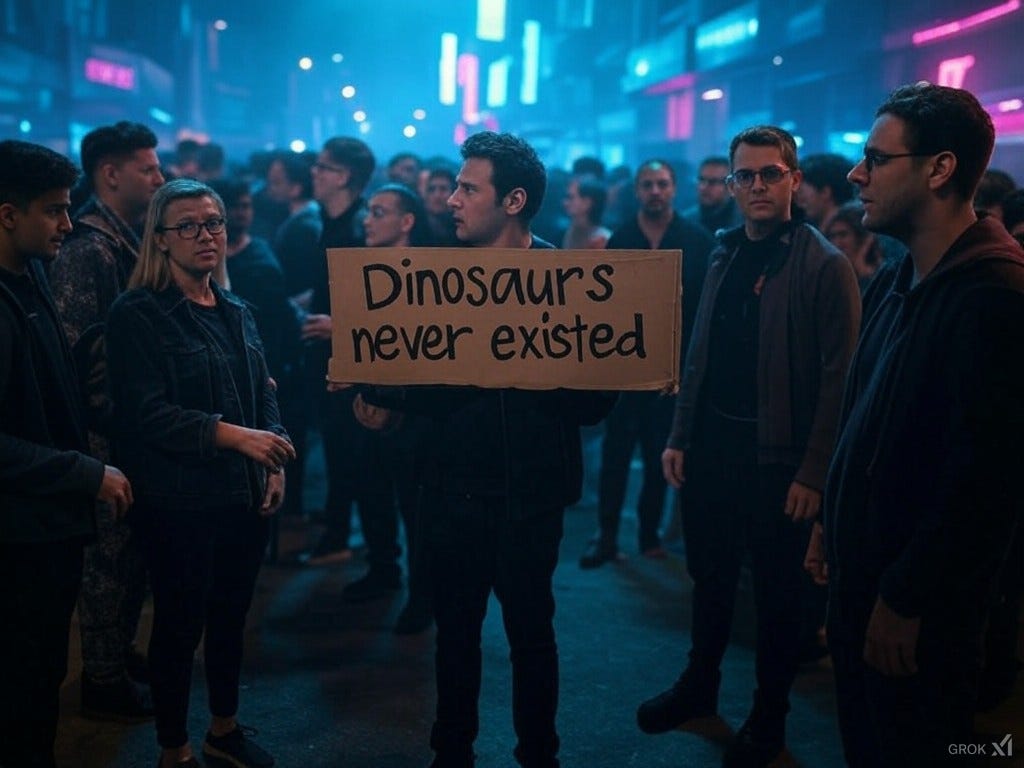The Leverage of Conspiracy Theories to Obfuscate Legitimate Concerns: How You've Been Influenced Without Noticing
From 'Viruses Don't Exist' Fairy-Tales to 'Ivermectin Magic' & 'Lab-Leak' Sci-Fi: How Conspiracy Theories Distract from Reality
This summary is the culmination of an extensive conversation with Grok, where I prompted an in-depth exploration of several issues with which I was already familiar. I think it’s a very important topic to pay attention to; I hope you enjoy the reading. There is AI generated audio available 🙏
NOTE: Keep in mind that the use of absurd narratives, such as ‘Viruses Don’t Exist’, ‘The Mind-Control Chips Linked to 5G via Inoculation & Graphene Oxide’, ‘The Lab-Leak Sci-Fi Drama Movie’, ‘The Ivermectin Magic’, ‘The Spike Magic’… and many others, are deliberately introduced and artificially promoted in order to discredit legitimate concerns and to disrupt balanced public discourse. In the following, I will talk in general terms, without referring to concrete examples.
I’ve included a clarification that was not present in the first release of this article. There is no audio available for this part. Clarification: There is no positive use of the word ‘Conspiracy Theory'‘. My reasoning is as follows: You cannot put under the same umbrella disparate narratives, which are fundamentally distinct in nature, such as 'Dinosaurs never existed' and the Tuskegee experiments, even at a time when the experiments were not publicly acknowledged and still they were considered a so-called 'conspiracy theory'. If we use the same umbrella-word, that is, 'conspiracy theories' to classify such divergent and unrelated narratives, it becomes very easy to discredit legitimate concerns. No legitimate concern should ever be dismissed as 'conspiracy theories'. How can we then avoid using the term 'conspiracy theory' in order to protect legitimate concerns or prudent investigations of current affairs? First of all, objectors to a given subject, with legitimate concerns and evidence-based approaches must NEVER allow themselves to be associated with any conspiracy theory or alternative movement. Example, legitimate concerns on experimental vaccine products cannot include a subset of people stating that 'viruses don't exist' or that 'there are mind-control chips in the vaccines'. Otherwise, all their efforts will become futile. However, the reality is that such groups coexist together, they are collectively called 'conspiracy theorists' and even those in the group, with real and genuine legitimate concerns, start to try and give themselves a good light to being called conspiracists, as if it was a medal of honor, when in reality is just self-defeating.
Here's how we might approach the conflation of baseless claims with legitimate inquiries or skepticism, to better distinguish between the two:
Precision in Language:
Differentiate Terms: Instead of using "conspiracy theory" as a catch-all, we can use more precise language. For example:
Speculative Hypothesis: For ideas without substantial evidence but not necessarily disproven.
Unverified Claim: For assertions where evidence is lacking or contested.
Investigative Inquiry: For legitimate concerns that are based on some form of evidence or logical reasoning but require further investigation.
Avoid Ambiguity: When discussing or reporting on issues, clearly state the level of evidence or lack thereof. This prevents the lumping together of disparate narratives under one label.
Promote Evidence-Based Discourse:
Encourage Evidence Presentation: In discussions or debates, insist on evidence for claims. This naturally separates baseless assertions from those with some grounding.
Critical Evaluation: Teach and practice critical thinking where claims are evaluated based on their merits, not their association with other unrelated claims.
Community and Self-Regulation:
Community Standards: Within communities discussing alternative narratives, set standards that reject association with clearly baseless claims. Groups with legitimate concerns should actively distance themselves from unfounded theories.
Self-Identification: Individuals or groups with legitimate concerns should not embrace the label "conspiracy theorist" if it's used to demean or discredit. Instead, they should focus on credibility through transparency and evidence.
ORIGINAL TEXT (with audio available):
The Intersection of Conspiracy Theories, Legitimate Concerns, and Strategic Influence
Overview:
Complex interplay exists between genuine public concerns, conspiracy theories, and strategic manipulation by various powers (industries, governments, etc.). This dynamic often results in the discreditation of legitimate inquiries by associating them with absurd or baseless narratives.
Why Conspiracy Theories Intersect:
Cognitive and Social Factors: Individuals seek patterns, community, and explanations for their worldviews, leading to the adoption of multiple conspiracy theories that might seem unrelated but offer a sense of coherence or belonging.
Mistrust in Authority: A common distrust in institutions can lead to a broader acceptance of alternative narratives that challenge mainstream science or policy.
Legitimate Concerns vs. Conspiracy Theories:
There are real issues like public health, government transparency, and corporate accountability that deserve scrutiny. However, when these concerns are met with denial or obfuscation, they can be co-opted or discredited by associating them with fringe beliefs (such as the ones mentioned above).
Strategic Manipulation:
Discreditation by Association: By linking legitimate movements with absurd conspiracy theories, critics can be easily dismissed as irrational or paranoid.
Unwitting Influencers: Some influencers might be unknowingly used as tools for narrative control. Their content is amplified not through direct manipulation but by promoting those whose views serve specific interests.
Selection and Promotion: Interests might seek out and boost influencers who naturally align with or can be swayed towards narratives that benefit them, without explicit instructions.
Plausible Deniability: This method provides a layer of protection where any legitimate critique can be bundled with the ridiculous, offering a defense against scrutiny.
Impact and Challenges:
Muddying the Waters: The strategy effectively dilutes public discourse, making it hard to differentiate between legitimate concerns and misinformation.
Grassroots Movements: Legitimate movements must combat not only the issues they're addressing but also the perception that they're associated with conspiracy theories.
Detection and Ethics: Identifying such manipulation is challenging due to the lack of direct evidence of coordination, emphasizing the need for better media literacy and platform transparency.
Examples and Implications:
Historical and contemporary examples show how industries or governments might use or have used similar tactics to control narratives around smoking, climate change, vaccines, etc.
The implications are profound, affecting public policy, health, environmental action, and social cohesion, as trust in information becomes increasingly eroded.
The phenomenon of conspiracy theories intersecting with legitimate concerns is not just about individual belief but reflects broader societal, psychological, and strategic dynamics. Understanding this interplay is crucial for fostering an informed public capable of discerning truth from manipulation, advocating for transparency, and ensuring that genuine issues are addressed without being overshadowed by the absurd or the strategically manipulated.
Approaches to Address the Issue:
Handling the Issue:
Avoid Over-Representation: Instead of focusing on debunking or labeling, the emphasis should be on not over-representing or sensationalizing fringe views, which can give them undue prominence.
Focus on Engagement: Encourage dialogue that addresses the underlying issues or misinformation without attacking the person or group. This involves listening to and understanding why such beliefs are held, then engaging with evidence-based conversation.
Clear Differentiation: Work to clearly differentiate legitimate concerns from conspiracy theories through factual reporting, education, and by highlighting the evidence and methods of those advocating for legitimate issues.
Support for Legitimate Movements: Provide platforms, media coverage, and policy support for movements based on sound evidence, ensuring they are not overshadowed by fringe narratives.
Educational Strategies: Implement educational strategies that teach critical thinking, media literacy, and the nuances of scientific inquiry, helping individuals to better navigate complex information environments.
Media Responsibility: Encourage media to report on these topics with nuance, avoiding sensationalism and ensuring that coverage does not inadvertently amplify misinformation.
Conclusion: Labeling can have the opposite effect of what's intended when dealing with conspiracy theories and legitimate concerns. It's crucial to approach this issue with sensitivity to avoid amplifying fringe beliefs, to maintain the integrity of public discourse, and to ensure that real issues are addressed without being dismissed due to association with misinformation. The strategy should pivot towards constructive engagement, education, and clear differentiation between fact and fiction.






''The Leverage of Conspiracy Theories to Obfuscate Legitimate Concerns: How You've Been Influenced Without Noticing.''
Totally agree and the proof is provided below. Long spoken of in ''awake'' circles as being a ''whitewash'' despite those making such claims not even reading any witness statements nor watching the live sessions. The most serious psy-op of them all as it's trashes any possibility of accountability when millions of people refuse to watch.
https://biologyphenom.substack.com/p/newinquiry-whitewash-or-something